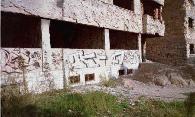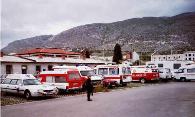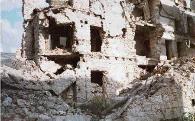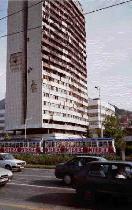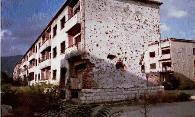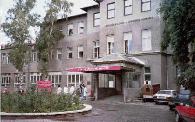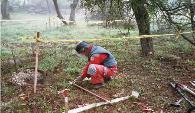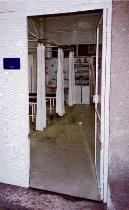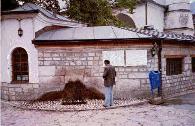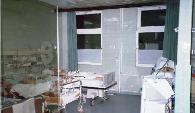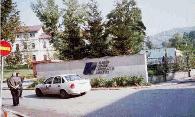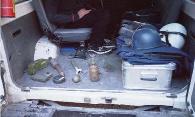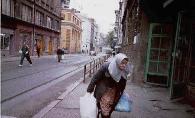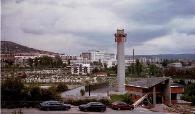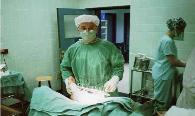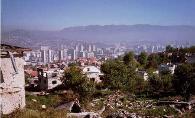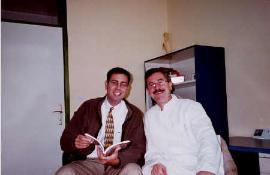Final Observations: YIP
Emergency Medical Care:
As with the other aspects of health care in Bosnia-Herzegovina, emergency
medical services are administered separately in each canton. There is little
coordination between hospitals and the DZs and Ambulantana and cooperation
between FBiH and RS is virtually non-existent. Sarajevo has the most well
developed emergency services system, but it too is flawed. The central EMS
“POMOC” is located in downtown Sarajevo and the director is Dr. Jasminka
Kovacevic. The center is equipped to handle minor injury and medical cases and
has a dispatcher which responds to telephone calls to the number 94, a centralized
emergency number. Chronic medical issues are dealt with on the number 611-
111. Ambulances are dispatched to transport patients either to the Pomoc center,
the State Hospital or the University Hospital. The University Hospital is estimated to
receive 80% of all emergency cases. There is a trauma room for resuscitation and
stabilization for patients brought directly from the community to the center.
The Sarajevo EMS has a new fleet of well-equipped ambulances with
Emergency Medical Technicians that have receive basic training. Although Basic
and Advance Life Support is taught, some concern was expressed about the skill
level of the EMTs. There were also concerns expressed about the lack of
coordination with other cantons and the RS and the duplication of resources
between the EMS center and the hospitals.
Emergency services are provided at the University Hospital under the
coordination of Dr. Zoran Hadziahmetovic, a trauma surgeon. The department was
recently reorganized in order to expedite care for injured patients. Patients that
are brought in by ambulance or from the community are assessed in a holding
area and resuscitated as needed. X-rays are nearby, as are operating rooms and
an intensive care unit should further stabilization be required. A separate building
houses the CT scanner and angiography that presents problems if these
modalities are needed. The orthopedic and trauma clinic are located in a separate
building as well, but patients are not transferred to other departments until they
have stabilized or are only single organ problems.
The situation in the cantons is more problematic. While the major hospitals of
Mostar, Zenecia and Tuzla are relatively better equipped there is minimal
coordination between the outlying clinics. One example was recently shown when
a patient was diagnosed with a myocardial infarction in a DZ and was transported
to a hospital without any interventions and subsequently died in route.
The staff at the hospitals are aware of the necessity to improve first aid and
basic life support, however, there appears to be hesitance from the other doctors
to accept such teaching. For example, the emergency physicians at the Zenecia
hospital were trained to American standards by IMC, an American non-
governmental organization. Despite superior training, these physicians feel
abandoned by the international community and do not have the support of the
Federal Ministry of Health to disseminate proper medical teaching or provide
expanded emergency services to the community.
The international demining community also expressed concern about the lack of
a proper integrated emergency services system and the level of care at the major
hospitals. Norwegian People’s Aid expressed dissatisfaction with the care an injure
deminer rectenly received at the University of Sarajevo Hospital and recently
prepared a new contract with the State Hospital.
Observations:
Lack of coordination between cantons and municipalities for emergency medical
services.
Lack of training in first aid and basic life support in DZs and villages.
Lack of information and education for prevention of injuries and outpatient
therapies.
Duplication of resources by emergency services organizations and hospitals.
Lack of integration between international community and EMS system, specifically
with regard to demining operations.
Recommendations:
Develop integrated plan for emergency medical services for entire country. Need
for coordination between cantons and major hospitals and need for improved
services by primary care workers in villages and clinics.
In working toward this aim a conference is planned for mid October to critically
evaluate the current EMS system with plans for changes.
Encourage prevention strategies to reduce the risk of various injuries such as car
crashes or falls.
Need for research to document which injuries are most prevelant and discover risk
factors and areas for intervention strategies.
Surgical Services:
The World Bank undertook a project for War Victims Rehabilitation from 1996-
1999. Part of this project was to improve the surgical and orthopedic capability of
8 hospitals in the Federation. This project was for the most part successful,
although lack of benchmarks and baseline data hindered an adequate
assessment. A second project of essential hospital services was also carried out
in order to help equip hospitals.
The long-standing system in BiH of centralized medical care has contributed to a
relatively high level of surgical services at the detriment to primary care. The
county is currently able to provide such care as laparoscipic cholcystectomy and
renal transplantation. Although these are wonderful services for the patients who
receive them, there may be a difficulty in justifying the relatively high expenditures.
The level of clinical expertise can be considered very good given the pre-war
level of competence and the experience gained in the management of serve
injuries. Many of the war time experiences have been documented an a congress
in 1996 showed this.
The problems of limited equipment and supplies and the lack of coordination
and treatment in the surrounding cantons also affect hospital services.
Inappropriate transport or prolonged times may be responsible for increased acuity
of patients receiving care.
Observations:
High level of clinical experience.
Lack of access to new literature and cooperation with international community.
Good ability to accomplish sophisticated operations.
Lack of coordination with various cantons and primary care.
Limited funding for salaries and high level of discontent among health care workers.
Recommendations:
Educational exchanges of residents, surgeons and literature between domestic
and international teaching hospitals.
Improved recording of injury data and use of resources.
Need to improve efficiency within existing structure and also with health system
reorganization.
Move to increased outpatient surgery for elective cases and low risk surgery.
Emergency Medical Care:
As with the other aspects of health care in Bosnia-Herzegovina, emergency
medical services are administered separately in each canton. There is little
coordination between hospitals and the DZs and Ambulantana and cooperation
between FBiH and RS is virtually non-existent. Sarajevo has the most well
developed emergency services system, but it too is flawed. The central EMS
“POMOC” is located in downtown Sarajevo and the director is Dr. Jasminka
Kovacevic. The center is equipped to handle minor injury and medical cases and
has a dispatcher which responds to telephone calls to the number 94, a centralized
emergency number. Chronic medical issues are dealt with on the number 611-
111. Ambulances are dispatched to transport patients either to the Pomoc center,
the State Hospital or the University Hospital. The University Hospital is estimated to
receive 80% of all emergency cases. There is a trauma room for resuscitation and
stabilization for patients brought directly from the community to the center.
The Sarajevo EMS has a new fleet of well-equipped ambulances with
Emergency Medical Technicians that have receive basic training. Although Basic
and Advance Life Support is taught, some concern was expressed about the skill
level of the EMTs. There were also concerns expressed about the lack of
coordination with other cantons and the RS and the duplication of resources
between the EMS center and the hospitals.
Emergency services are provided at the University Hospital under the
coordination of Dr. Zoran Hadziahmetovic, a trauma surgeon. The department was
recently reorganized in order to expedite care for injured patients. Patients that
are brought in by ambulance or from the community are assessed in a holding
area and resuscitated as needed. X-rays are nearby, as are operating rooms and
an intensive care unit should further stabilization be required. A separate building
houses the CT scanner and angiography that presents problems if these
modalities are needed. The orthopedic and trauma clinic are located in a separate
building as well, but patients are not transferred to other departments until they
have stabilized or are only single organ problems.
The situation in the cantons is more problematic. While the major hospitals of
Mostar, Zenecia and Tuzla are relatively better equipped there is minimal
coordination between the outlying clinics. One example was recently shown when
a patient was diagnosed with a myocardial infarction in a DZ and was transported
to a hospital without any interventions and subsequently died in route.
The staff at the hospitals are aware of the necessity to improve first aid and
basic life support, however, there appears to be hesitance from the other doctors
to accept such teaching. For example, the emergency physicians at the Zenecia
hospital were trained to American standards by IMC, an American non-
governmental organization. Despite superior training, these physicians feel
abandoned by the international community and do not have the support of the
Federal Ministry of Health to disseminate proper medical teaching or provide
expanded emergency services to the community.
The international demining community also expressed concern about the lack of
a proper integrated emergency services system and the level of care at the major
hospitals. Norwegian People’s Aid expressed dissatisfaction with the care an injure
deminer rectenly received at the University of Sarajevo Hospital and recently
prepared a new contract with the State Hospital.
Observations:
Lack of coordination between cantons and municipalities for emergency medical
services.
Lack of training in first aid and basic life support in DZs and villages.
Lack of information and education for prevention of injuries and outpatient
therapies.
Duplication of resources by emergency services organizations and hospitals.
Lack of integration between international community and EMS system, specifically
with regard to demining operations.
Recommendations:
Develop integrated plan for emergency medical services for entire country. Need
for coordination between cantons and major hospitals and need for improved
services by primary care workers in villages and clinics.
In working toward this aim a conference is planned for mid October to critically
evaluate the current EMS system with plans for changes.
Encourage prevention strategies to reduce the risk of various injuries such as car
crashes or falls.
Need for research to document which injuries are most prevelant and discover risk
factors and areas for intervention strategies.
Surgical Services:
The World Bank undertook a project for War Victims Rehabilitation from 1996-
1999. Part of this project was to improve the surgical and orthopedic capability of
8 hospitals in the Federation. This project was for the most part successful,
although lack of benchmarks and baseline data hindered an adequate
assessment. A second project of essential hospital services was also carried out
in order to help equip hospitals.
The long-standing system in BiH of centralized medical care has contributed to a
relatively high level of surgical services at the detriment to primary care. The
county is currently able to provide such care as laparoscipic cholcystectomy and
renal transplantation. Although these are wonderful services for the patients who
receive them, there may be a difficulty in justifying the relatively high expenditures.
The level of clinical expertise can be considered very good given the pre-war
level of competence and the experience gained in the management of serve
injuries. Many of the war time experiences have been documented an a congress
in 1996 showed this.
The problems of limited equipment and supplies and the lack of coordination
and treatment in the surrounding cantons also affect hospital services.
Inappropriate transport or prolonged times may be responsible for increased acuity
of patients receiving care.
Observations:
High level of clinical experience.
Lack of access to new literature and cooperation with international community.
Good ability to accomplish sophisticated operations.
Lack of coordination with various cantons and primary care.
Limited funding for salaries and high level of discontent among health care workers.
Recommendations:
Educational exchanges of residents, surgeons and literature between domestic
and international teaching hospitals.
Improved recording of injury data and use of resources.
Need to improve efficiency within existing structure and also with health system
reorganization.
Move to increased outpatient surgery for elective cases and low risk surgery.
Bosnia
Trauma and Reconciliation in Bosnia - Herzegovenia
National Academy of Sciences: Young Investigators Program (YIP)
September 2000
Trauma and Reconciliation in Bosnia - Herzegovenia
National Academy of Sciences: Young Investigators Program (YIP)
September 2000
